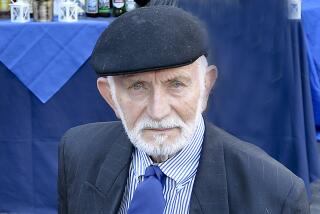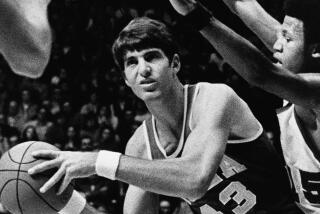Former Oklahoma A&M; Star : Kurland Never Regretted Decision Not to Turn Pro
- Share via
BARTLESVILLE, Okla. — In his last two college basketball seasons, 6-foot-10 Bob Kurland led Oklahoma A&M;, now Oklahoma State, to the 1945 and 1946 NCAA championships. He was named MVP in both tournaments, the first player to win the honor twice in a row.
Today, those credentials would be worth a dazzling contract in the NBA. At that time, Kurland had two options but neither of them would make him an instant millionaire.
He could go into one of the struggling pro leagues as did a contemporary giant, George Mikan of DePaul. Or he could join the flourishing AAU program in which major companies sponsored powerful teams for public relations purposes and offered on-the-job training as a career company man.
Kurland opted for the AAU’s famous Phillips 66ers. He led the 66ers for six seasons and played on the U.S. Olympic teams in London in 1948 and in Helsinki in 1952 under his old college coach, Hank Iba. He never regretted his decision and still is with the company 40 years later.
“In 1946, there were very few places a basketball player could go,” Kurland said, sitting in his 7th floor office at Phillips Petroleum Co. “My conservative approach was to come to the corporation.”
He has enjoyed his career, he said, and has a standard answer for people who ask him whether he wished he had been born 30 years later to cash in on a professional player’s contract.
“I’m just happy I wasn’t born 30 years sooner,” he said.
While Kurland is thought of as one of the first 7-0 players to dominate college basketball, he’s not that tall. But in the 1940s, he was considered “a glandular goon” at his height of 6-10, he said.
Kurland was considered to be one of the reasons the NCAA adopted its goal-tending rule in 1944.
Since retiring as a player, he has worked in various capacities for Phillips to reach his position in the marketing department as manager of special product sales.
Kurland, a native of St. Louis, said at times coach Iba was like a father to him. Several colleges showed little enthusiasm about Kurland coming to play basketball for them, because at his height he was considered an oddity, he said.
“ ‘I don’t know whether you can play college ball or not . . . but I’ll see you’ll get a degree,’ ” he said Iba told him. “And what he told you, you could believe.”
Kurland could play, and Iba designed the offensive and defensive plays around him, he said.
“The big difference today is you have tall athletes who have the same skills as players who were 6-0 or 6-3,” he said.
In his college days, a coach could make a basketball player out of a student who had desire, but today they must have “God-given talent,” he said.
More to Read
Go beyond the scoreboard
Get the latest on L.A.'s teams in the daily Sports Report newsletter.
You may occasionally receive promotional content from the Los Angeles Times.










